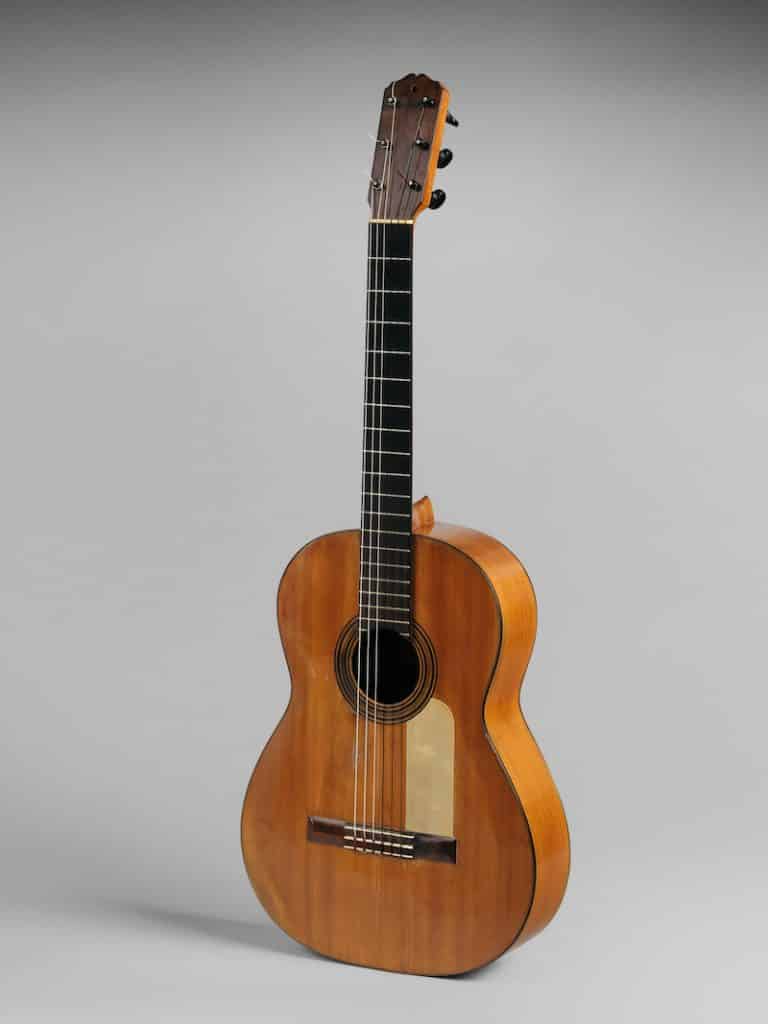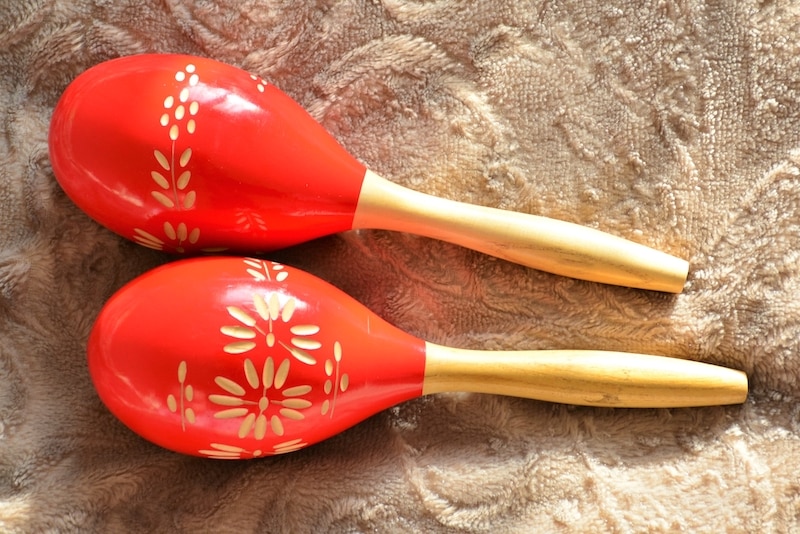The Spanish are known for their rich culture with both food and music being high on the list of things that are important to them. One thing that sets Spanish music apart from other countries’ musical traditions is its diversity in instrumentation. From medieval times to today, Spain has created instruments that have been passed down through generations in order to play their beloved songs.
Whether you’re considering learning them or just want to be better educated when next listening to some flamenco, this article will explore 12 traditional Spanish musical instruments that are popular in the country.
1. Flamenco Guitar

The Flamenco guitar is very similar to classical guitar in that you use nylon strings instead of steel strings, such as on other guitars.
They have a few differences in their action, woods used, height, and thickness but the most significant difference is in the right-hand technique as to play flamenco guitar, you will use your first and second fingers to pluck the strings.
One technique you might use when playing in this style is picado, which is where you play a melody with one note, and you mute the string right after you play the note each time.
You’ll also use your right thumb a lot when playing flamenco guitar.
The thumb is a huge part of playing arpeggios and playing alzapua which is a technique where your thumb will stroke the strings up and down, and you can play individual notes or chords.
2. Castanets
Castanets are another traditional Spanish instrument, which is part of the percussion family of instruments.
They can be made of different materials, such as ivory or hardwood.
You will usually use castanets to play along with folkloric or classical dances and they’re often seen played by a flamenco dancer.
When playing folkloric music, they’re typically worn on one or more of your fingers on each hand.
Then, you’ll flick the castanets against your wrists to make sound.
You can also get smaller castanets that you attach to your thumbs to play in a classical style.
When playing in a classical style, you’ll also use your right-hand castanet to play more complex rhythms, while the left-hand rhythms remain simple.
3. Accordion
The accordion made its Spanish debut in the 1870s when people in the Pyrenees mountains began to play it.
Sailors introduced the instrument to Spaniards along the Mediterranean and it was usually played either alone, with percussion or the violin.
Eventually, people in Barcelona and Valencia started making accordions.
Over the decades, players have shifted between preferring the diatonic accordion and the chromatic accordion, which offers more notes.
The musician Arthur Blasco helped bring the accordion back into use in the 1970s.
He later founded an association that focuses on teaching people how to play the Catalonian accordion.
While it’s not the most common instrument, people have continued to play it for years and it’s a common sight in Spanish music.
4. Timple
If you head to the Canary Islands, an outer region of Spain, you’ll find the timple which is an instrument that’s popular in Canarian bands and looks like a small guitar.
You play it very similarly to how you play the guitar, but it only has five strings.
It looks almost like the ukulele, and it has similar origins, such as the Portuguese cavaquinho.
The instrument uses wood, including pine, white spruce, and ebony, and people used to use cow bones to make the pegs, but now synthetic materials are more popular.
You can visit Teguise in the Canary Islands to see the Casa-Museo de Timple where you can learn even more about the instrument and its history.
You may also be able to watch a live concert of musicians playing the timple to see it in action.
5. Cajón
Spanish for “box,” the cajón is one of the most popular Spanish percussion instruments.
While it’s not a Spanish native, you can find the instrument in other countries, many of them are Spanish colonies.
Thecajón was developed when people in the colonies banned drums and people had to improvise.
Players will sit on the cajón to play it, and they’ll hit the side of the instrument with their hands.
You can find cajóns in different sizes and at various pitch levels which makes it easy to find an instrument that will work with the music you want to play.
When Spanish musicians toured South America in the 1970s, they liked the instrument bringing it back to Spain.
It has since become a staple in flamenco and other Spanish styles of music.
6. Bandurria
The bandurria is another string instrument similar to a guitar that has a small body with a flat back and a short neck.
A type of lute, it was invented in the 16th century and so was very a popular renaissance instrument with lots of composers writing for it extensively.
You can find bandurrias with five, six, or seven strings, though six strings is the most popular configuration and they’re tuned in intervals of a perfect fourth apart.
It’s an important instrument in a lot of Spanish music, and it has influenced instruments in Latin America.
If you find the instrument in the Balearic Islands off the coast of Valencia, you may hear people call it the mandurria.
7. Vihuela
The vihuela is yet another string instrument that comes from Spain.
It was developed in the 16th century so that people had something to play polyphonic music on.
You play the instrument with your fingers, though none of the original vihuelas still exist, so it’s hard to tell the original intentions.
It features six courses of strings, though some of the “courses” have two strings which means that the instrument can have up to 12 strings.
The design can make it harder to play, but you can use it as a solo instrument due to its polyphonic nature.
Size-wise, it’s only about three feet long, so it’s a lot smaller than the guitar.
It also uses nylon or gut strings, which were popular when the instrument first came to life.
8. Gaita Gastoreña
If you prefer to play or listen to wind instruments, you may enjoy the Gaita gastoreña.
The hornpipe originated in the Andalusia region of El Gastor and interestingly it uses a reed to play it, and the air will then move through a wooden tube before going out through a bell.
Traditionally, young people were usually the only ones to play it and they would only play it towards the end of the year in the month of November and December.
After the end of Christmas, people would store the Gaita gastoreña until the following November.
Now, people will play it during the Festival of Corpus Christi which occurs about two months after Easter.
9. Laud
Spanish for “lute,” the laud is another string instrument you’ll find in Spain.
It’s similar to the bandurria and other string instruments, however, the laud’s neck is longer than that on a bandurria.
This instrument uses 12 strings across six double courses and is often played with the bandurria, guitar, and other folk instruments.
It’s a common part of Spanish folk music, and you’ll typically see it being performed in a musical group called the rondalla.
10. Tabor
The tabor looks like a lot of other drums, and it has two membranes that you can strike to play the instrument.
Explorers came up with the idea for the tabor in the 1200s and early musicians would play the tabor and a pipe together.
Its most common use at first was in courts and civic events.
About 200 years later, people started creating larger tabors, and they would use two sticks to play the instrument.
Musicians would play the tabor as part of fife and drum music for the military.
When it comes to the original design, players would hold a string on the instrument so that they could strike it without affecting the vibrations.
While it became less common with time, musicians started to play the instrument again after historical performance practice started gaining popularity.
11. Bongos
One of the most well-known Spanish instruments has to be the bongos.
While it’s not native to Spain, having originated in the Afro-Caribbean countries, the small pair of small drums are popular in a variety of Spanish genres, from traditional music to western classical music.
One drum is bigger than the other, so you can get different sounds from each bongo and to play it you’ll need to sit and place the bongos between your knees.
While it’s not very common in Spanish music, Spanish-speaking countries such as Cuba use the bongos a lot.
You can find people playing the bongos in a lot of different genres in Cuba and other Afro-Cuban areas.
12. Maracas

Another popular instrument in Spain that most people will have heard of is the maracas.
These small percussion instruments didn’t originate in Spain but most likely got their start in Puerto Rico by the Taino people.
Nowadays you’ll find maracas made out of plastic and wood, but originally they were made out of the fruit from the Higuera tree.
Musicians would hollow out the fruit and add pebbles, and they would attach handles.
Summing up our List of Instruments From Spain
If you like Spanish music, you should definitely know about some of these Spanish instruments.
Then, when you’re next listening to some flamenco you can listen out for what instruments are in your favorite songs.
You may even decide to learn one!
